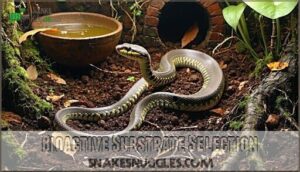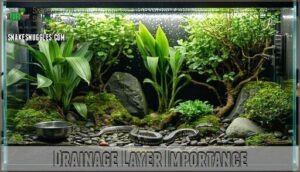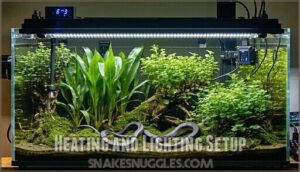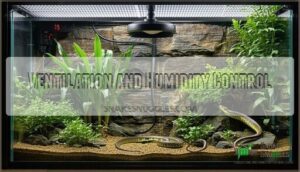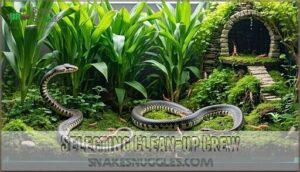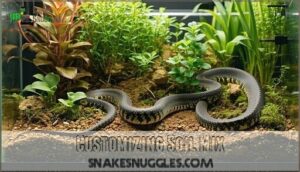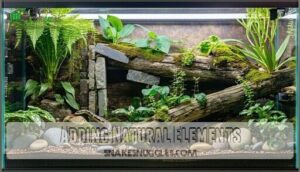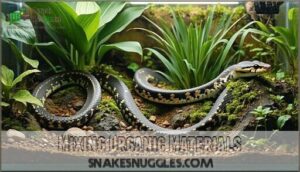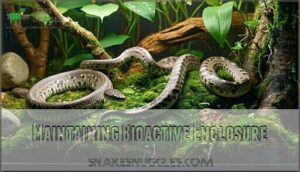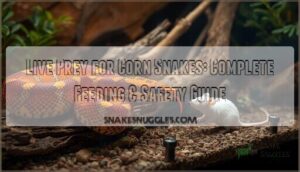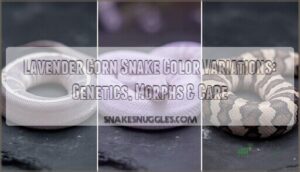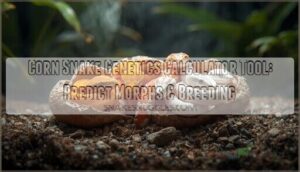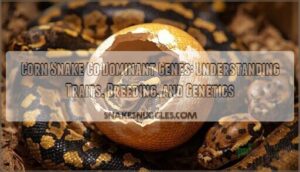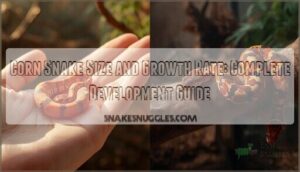This site is supported by our readers. We may earn a commission, at no cost to you, if you purchase through links.
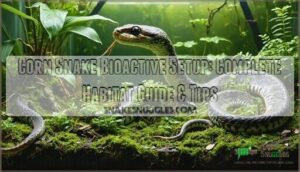
You’ll need springtails and isopods as your cleanup crew to break down waste naturally.
Install appropriate heating elements, UVB lighting, and maintain 40-60% humidity.
Add snake-safe plants like pothos or sansevieria for natural cover, this living ecosystem reduces cleaning while letting your snake exhibit natural behaviors like burrowing.
The initial setup requires patience, but the microbial balance and plant establishment create fascinating interactions you won’t expect.
Table Of Contents
- Key Takeaways
- Choosing Snake Species
- Bioactive Substrate Selection
- Setting Up Terrarium
- Selecting Clean-up Crew
- Creating Substrate Mix
- Maintaining Bioactive Enclosure
- Frequently Asked Questions (FAQs)
- Can I put isopods with my corn snake?
- What is the biggest trouble with corn snakes as pets?
- How often should I feed my corn snake in bioactive setup?
- Can I use tap water for misting the enclosure?
- How long before introducing snake to new bioactive setup?
- Should I quarantine new cleanup crew before adding them?
- Conclusion
Key Takeaways
- Start with a proper drainage layer and 4-6 inches of substrate mix containing organic topsoil, cypress mulch, and sphagnum moss to create the foundation your corn snake needs for natural burrowing behaviors
- Add springtails and isopods as your cleanup crew – they’ll break down waste naturally and reduce your cleaning maintenance by up to 80% compared to traditional setups
- Install appropriate heating elements and UVB lighting while maintaining 40-60% humidity levels, then add snake-safe plants like pothos for natural cover and environmental enrichment
- Allow 2-4 weeks for the ecosystem to establish before introducing your snake – this lets the cleanup crew colonize and plants acclimate, creating a self-sustaining bioactive environment
Choosing Snake Species
Selecting the right snake species for your bioactive enclosure determines your setup’s success and your pet’s long-term health.
While corn snakes excel in bioactive systems due to their adaptability and natural burrowing behaviors, ball pythons and western hognose snakes each bring unique care requirements.
These unique care requirements affect substrate choice, humidity levels, and cleanup crew selection, which are critical factors in maintaining a healthy bioactive environment for your pet snake, including considerations for bioactive systems.
Ball Pythons as Pets
Ball pythons make gentle companions for exotic pets enthusiasts, though they’re not the focus of this corn snake care guide.
These docile reptiles require consistent python behavior understanding and specialized pet handling techniques.
Their snake nutrition needs differ from corn snakes, demanding specific bioactive setup considerations.
While ball python care involves similar bioactive enclosure principles, corn snakes offer easier reptile substrate management for beginners.
Understanding ball python care is essential for providing the right environment for these pets.
Corn Snakes Adaptability
Adaptability makes corn snakes perfect for bioactive setups.
These resilient reptiles thrive where others struggle, making bioactive dreams reality.
These resilient reptiles handle Environmental Tolerance ranging from humid forests to dry meadows.
Their Adaptive Traits shine in corn snake bioactive enclosures, where Habitat Flexibility lets them thrive across temperature gradients.
Climatic Resilience means your bioactive setup doesn’t need perfect conditions—corn snake care becomes manageable when Snake Behavior naturally adjusts to environmental changes, showcasing their ability to thrive in various conditions with Environmental Tolerance.
Western Hognose Snakes Behavior
Western hognose snakes are theatrical performers when threatened, flattening their necks like cobras and hissing dramatically.
Their defensive postures include rolling over and playing dead with mouths agape.
These burrowing specialists use upturned snouts for digging through bioactive substrate.
Their hunting strategies focus on amphibians and small reptiles in natural habitat environments requiring specialized terrarium maintenance.
Bioactive Substrate Selection
You’ll need the right substrate ingredients to create a thriving bioactive environment that mimics your corn snake’s natural southeastern habitat.
The substrate depth and moisture control you choose will directly impact your snake’s health, shedding success, and the ecosystem’s ability to break down waste naturally, which is crucial for a healthy and thriving environment with proper moisture control.
Ingredients for Substrate
Now that you’ve picked your snake species, you’ll need the right bioactive substrate ingredients.
Start with organic topsoil as your base – it’s like the foundation of a house.
Mix in coconut coir for moisture retention and peat moss to balance pH levels.
Add clay particles and LECA for drainage.
This topsoil mix creates the perfect home for beneficial microbes and clean-up crews.
Choosing Substrate Depth
For juvenile corn snakes, you’ll want 2.5-4 inches of bioactive terrarium substrate to support their burrowing needs without overwhelming them.
Adults thrive with 4-8 inch substrate layers, allowing natural digging behaviors.
Proper substrate depth creates temperature gradients and supports beneficial microfauna.
Consider your snake’s size when determining substrate layering – deeper isn’t always better for smaller specimens seeking security.
The quality of the bioactive substrate is vital, as it affects the overall bioactive substrate health in the terrarium, which is crucial for maintaining a healthy environment with beneficial microfauna.
Substrate Moisture Control
Proper moisture levels make the difference between thriving corn snakes and stressed reptiles. You’ll want substrate moisture around 50-60% RH for ideal health.
Here’s what happens when you get it right:
- Your snake sheds cleanly without stuck pieces
- Plants flourish while mold stays away
- Clean-up crews work efficiently breaking down waste
Monitor substrate humidity with digital probes. Check for wet pockets every few days. Mist when needed, not on schedule. Well-draining soil composition prevents waterlogged conditions that harm your snake’s respiratory system.
Setting Up Terrarium
Once you’ve prepared your substrate foundation, it’s time to build the structural elements that’ll keep your corn snake healthy and comfortable.
The terrarium setup focuses on three critical systems: proper drainage to prevent waterlogged soil, controlled heating and lighting that mimics natural conditions, and ventilation that maintains ideal humidity without creating stagnant air.
Drainage Layer Importance
Your drainage layer acts like a foundation that prevents waterlogging while supporting healthy substrate moisture levels.
Install 1-2 inches of LECA clay pebbles at your terrarium’s bottom for ideal drainage materials.
This setup creates essential moisture control by allowing excess water to flow away from your substrate depth layers.
The drainage layer guarantees humidity control without creating soggy conditions that harm your corn snake’s health.
Heating and Lighting Setup
Creating the perfect heating and lighting setup transforms your bioactive corn snake habitat into a thriving ecosystem.
Heat mats placed under one-third of your enclosure establish essential temperature gradients, while thermostat control prevents dangerous overheating that could harm your snake.
The use of proper heat mat systems is vital for maintaining ideal temperatures.
- Position heating pad outside glass tanks to prevent substrate overdrying
- Install UVB lighting strips for plant photosynthesis and natural circadian rhythms
- Use LED lighting with 12-hour cycles to replicate seasonal patterns
- Maintain surface temperatures between 85°F-90°F with digital thermostat control
Ventilation and Humidity Control
Balance acts as your secret weapon here—you’ll need proper air exchange without creating drafts that stress your corn snake.
Install screen tops with adjustable vents to control airflow while maintaining steady humidity levels between 40-60%.
Strategic ventilation systems prevent stagnant air that breeds harmful bacteria.
| Ventilation Component | Humidity Impact | Temperature Effect |
|---|---|---|
| Screen lid coverage | Reduces moisture retention | Allows heat escape |
| Side vents | Promotes air circulation | Maintains thermal gradient |
| Fan systems | Controls condensation buildup | Prevents hot spots |
| Vent positioning | Balances moisture levels | Supports temperature gradients |
| Mesh density | Regulates evaporation rate | Influences aeration patterns |
Your moisture management strategy should work with natural temperature gradients rather than against them.
Position vents away from basking areas to preserve your thermal gradient while ensuring adequate aeration throughout the enclosure.
This approach will help maintain a healthy environment for your corn snake by preventing stagnant air and harmful bacteria.
Proper ventilation is crucial for the well-being of your pet, and a well-designed system can be a key factor in its health and happiness.
By following these guidelines, you can create a comfortable and safe space for your corn snake to thrive.
Selecting Clean-up Crew
Your bioactive corn snake enclosure needs a reliable clean-up crew to handle waste and prevent harmful bacteria buildup.
These tiny workers create a self-sustaining ecosystem that keeps your snake’s habitat fresh and healthy without constant manual cleaning, forming a reliable team with the clean-up crew.
Springtails for Waste Management
While springtails might look like tiny soil inhabitants, they’re actually powerhouse cleaners that’ll transform your bioactive terrarium into a self-maintaining ecosystem.
These microscopic cleanup crew members consume decomposing waste daily, preventing harmful bacteria buildup.
Here’s why springtails excel at waste management:
- Population Growth – Colonies double every 2-4 weeks under proper humidity conditions
- Waste Processing – Adult springtails consume their body weight in organic matter daily
- Mold Prevention – They eat fungal spores, reducing substrate contamination by 30%
- Species Selection – Folsomia candida offers high reproduction rates and adaptability
- Substrate Aeration – Their burrowing improves soil texture and plant root health
Maintain 50-60% humidity for ideal springtail care and ecosystem balance in your corn snake’s bioactive cleaning system.
Isopods for Ecosystem Balance
These tiny decomposers work alongside springtails to maintain your bioactive terrarium’s health.
You’ll find isopods breaking down organic matter while aerating soil through their natural tunneling behavior. They’re essential for proper microfauna management and long-term ecosystem balance in your corn snake’s habitat.
A balanced bioactive environment relies on ideal substrate moisture levels for the health of the ecosystem.
| Isopod Type | Primary Function | Best For |
|---|---|---|
| Dairy Cow | General cleanup | Beginner setups |
| Powder Blue | Soil aeration | Humid environments |
| Zebra | Waste processing | Moderate moisture |
| Dwarf White | Surface cleaning | Small terrariums |
| Orange | Deep substrate work | Established systems |
Fungi for Decomposition
Beneath your substrate’s surface, fungi work tirelessly to transform organic matter into nutrients.
These microscopic decomposers create mycelium networks that break down waste while maintaining microbial balance.
Fungal spores naturally colonize your bioactive ecosystem, supporting the decomposition process alongside other microfauna.
- Mycelium growth spreads through soil like nature’s recycling network
- White fuzzy patches signal healthy fungal colonies establishing territories
- Decomposition accelerates as fungi break down shed skin and waste
- Soil structure improves through natural fungal binding processes
- Microbial life flourishes in this underground partnership system
Creating Substrate Mix
Creating the perfect substrate mix for your corn snake starts with understanding what these adaptable reptiles need in their native southeastern habitats.
You’ll want to blend organic materials that provide proper drainage, moisture retention, and support for the beneficial microorganisms that keep your bioactive system thriving.
Customizing Soil Mix
Your soil mix becomes the foundation for everything your corn snake will experience.
Start with organic soil as your base, then customize the soil composition by adding 20-30% coco coir for moisture levels control and 20-40% play sand for drainage.
This substrate composition creates the perfect soil texture while maintaining proper pH balance between 6.0-7.2.
The organic matter supports nutrient cycling, mimicking your snake’s naturalistic habitat perfectly.
A well-designed bioactive substrate mix includes proper humidity control to create an ideal environment for your pet.
Adding Natural Elements
Nature’s artistry shines when you layer rock decor and driftwood throughout your naturalistic habitat.
These elements create microclimates while supporting your bioactive ecosystem.
Add cork bark for climbing opportunities and slate pieces for basking spots.
Live plants like pothos thrive among these features.
Strategic water features enhance humidity, while varied soil textures mimic wild conditions.
Moss addition completes your terrarium setup perfectly.
The use of cork bark pieces can enhance the overall aesthetic and functionality of the habitat.
Mixing Organic Materials
Once you’ve gathered your natural additives, combining organic materials requires attention to material ratio and moisture levels.
Mix organic top soil with coco coir at a 3:1 ratio, then blend in ecoearth for texture enhancement.
This bioactive substrate foundation supports healthy soil texture while maintaining proper drainage throughout your corn snake’s environment.
Maintaining Bioactive Enclosure
Once you’ve established your bioactive corn snake habitat, ongoing maintenance keeps the ecosystem healthy and thriving.
Regular monitoring and simple upkeep tasks guarantee your snake enjoys a stable, naturalistic environment year-round.
Monitoring Temperature and Humidity
Since temperature control and humidity levels directly impact your corn snake’s health, you’ll need reliable monitoring tools.
Place digital thermometers with probes at different heights to track heat gradients. Thermostat settings should maintain 75-85°F with a 90°F basking spot.
Use hygrometers for moisture management, keeping humidity between 40-60%. Your snake’s humidity tolerance varies, so consistent climate control prevents respiratory issues and shedding problems.
Maintaining humidity levels naturally is essential for a healthy bioactive setup.
Pruning Live Plants
Regular Plant Pruning keeps your bioactive setup healthy and prevents overgrowth.
Trim yellowing leaves and dead foliage weekly to maintain plant safety. Use clean scissors for Stem Cutting to avoid bacteria spread.
Remove excessive Root Maintenance growth that blocks hiding spots.
Proper Leaf Trimming encourages new growth while Foliage Management guarantees your snake has adequate space for movement and thermoregulation, which is crucial for bioactive setup.
Replacing Decorations Regularly
Beyond plant pruning, your bioactive terrarium decorations need regular updates too.
Rotate cork bark decor and other terrarium decorations every 3-4 months to prevent bacterial buildup and maintain environmental enrichment.
This decoration rotation keeps your corn snake engaged while ensuring habitat refresh.
Replace worn substrate replacement areas around decorations, as these spots collect waste and lose structural integrity over time, ensuring environmental enrichment.
Frequently Asked Questions (FAQs)
Can I put isopods with my corn snake?
Yes, you can add isopods to your corn snake’s bioactive setup. They’ll help break down waste, control mold, and maintain healthy substrate conditions without harming your snake.
What is the biggest trouble with corn snakes as pets?
You’ll likely struggle most with their escape artistry – corn snakes are incredible Houdinis who’ll find every tiny gap in their enclosure you missed during setup.
How often should I feed my corn snake in bioactive setup?
You’ll feed juveniles every 5-7 days and adults every 10-14 days. Bioactive setups don’t change feeding frequency, but they help process waste naturally between meals.
Can I use tap water for misting the enclosure?
Tap water contains chlorine and chemicals that can harm beneficial microorganisms in your bioactive setup.
You’ll want to use distilled or dechlorinated water for misting to keep your ecosystem healthy and thriving.
How long before introducing snake to new bioactive setup?
Give your new bioactive setup about 2-4 weeks to "settle in" before introducing your snake.
This allows springtails and isopods to establish colonies, plants to acclimate, and the ecosystem to stabilize naturally.
Should I quarantine new cleanup crew before adding them?
No, you don’t need to quarantine your cleanup crew. Springtails and isopods are typically disease-free and safe to add directly to established bioactive setups without risking contamination.
Conclusion
Studies show that bioactive enclosures can reduce cleaning maintenance by up to 80% compared to traditional setups.
Your corn snake setup for bioactive environments will transform into a self-sustaining ecosystem within 2-3 months.
The cleanup crew breaks down waste naturally while live plants improve air quality.
You’ll spend less time maintaining and more time observing fascinating natural behaviors.
Remember to monitor humidity levels consistently during the initial establishment period for ideal results.

